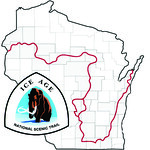This section of the Ice Age Trail is in the Northern Unit of the Kettle Moraine State Forest. Ice Age Trail Atlas map #87. Bring a compass and binoculars.
As the name implies, the Kettle Moraine area preserves the kettles, moraines, and other features left behind when the glacier retreated from the area approximately 12,000 years ago.
The viewpoint location is at the northern end of the middle Kettle Moraine section of the map below. You are in high relief hummocky landscape created by the interlobal actions of the glacier. The moraine area includes kettles, eskers, and erratics.


___________________________________________________________________
Graphics reprinted by permission of the University of Wisconsin Press. Mickelson, David M.. GEOLOGY OF THE ICE AGE NATIONAL SCENIC TRAIL.. ©2011 by the Board of Regents of the University of Wisconsin System.
_________________________________________________________________
 Kettles are created when a chunk of ice breaks off and is surrounded by glacial till until the ice melts.
Kettles are created when a chunk of ice breaks off and is surrounded by glacial till until the ice melts.
 Eskers are created by debris filled rivers flowing under a glacier.
Eskers are created by debris filled rivers flowing under a glacier.
And, of course, erratics are larger rocks carried by the glacier to the area.
 A kame is created when glacial till (sand and gravel) pours though a vertical shaft (called a moulin) in thin ice. This till piles up and when the ice melts after the many years, the conical shaped hill is formed. Kames are commonly surrounded by flat or low rolling topography, but are not normally located in proximity to one another .
A kame is created when glacial till (sand and gravel) pours though a vertical shaft (called a moulin) in thin ice. This till piles up and when the ice melts after the many years, the conical shaped hill is formed. Kames are commonly surrounded by flat or low rolling topography, but are not normally located in proximity to one another .
The bulk of the Lake Michigan lobe was to the east of this viewpoint. As you look toward the west, you will see kames created among the thinning ice of the Green Bay lobe and outwash left behind as both lobes melted away.
On a clear day, you can see a cell phone tower in the distance, slightly to the south of some of the kames. To provide a sense of distance, that tower is just a little over 3 miles away.
 IATCC is the cache designation to highlight a series of EarthCaches along the Ice Age National Scenic Trail grouped into a special category called "ColdCache."
IATCC is the cache designation to highlight a series of EarthCaches along the Ice Age National Scenic Trail grouped into a special category called "ColdCache."
The Ice Age Trail is one of eleven National Scenic Trails designated by the National Park Service. This unique trail is entirely within the state of Wisconsin and follows along the terminal moraine of the most recent glacier which retreated about 10,000 years ago.
This project is supported by the Ice Age Trail Alliance (IATA). The goal is to bring more visitors to the trail and promote public awareness, appreciation, and understanding of Wisconsin’s glacial landscape.
The IATA has created an awards program to encourage visits to the trail and ColdCache sites. This awards program is separate from, and in addition to, any other Geo- or EarthCache awards program.
A current list of approved ColdCache sites can be found on the “IATCC Bookmark List”. More information on the Ice Age Trail Atlas, the Companion Guide, the ColdCache Project and Awards Program can be found on the “ColdCache Webpage”
DNR Permission
The Geocache Notification Form has been submitted to Jason Quyast of the Wisconsin DNR. Geocaches placed on Wisconsin Department of Natural Resource managed lands require permission by means of a notification form. Please print out a paper copy of the notification form, fill in all required information, then submit it to the land manager. The DNR Notification form and land manager information can be obtained at: www.wi-geocaching.com/hiding
Resources
Geology of the Ice Age National Scenic Trail; by David M. Mickelson, Louis J. Mahler Jr., and Susan L. Simpson
To claim this find:
1. You are standing on a glacial feature among the moraine. What is it?
2. How many kames to you see nearby?
3. Which feature appears to be higher elevation; the feature your are standing on or the nearest kame? Why do you think this is so?